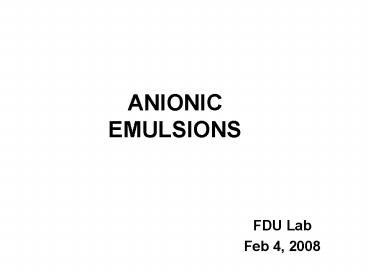ANIONIC EMULSIONS - PowerPoint PPT Presentation
1 / 29
Title:
ANIONIC EMULSIONS
Description:
BEESWAX-BORAX. Galen 200 AD- rose water in molten one part beeswax, 3-4 parts olive oil ... 5-7% wt beeswax = wt borax. TEA-STEARATE. Stearic acid CH3(CH2)16COOH ... – PowerPoint PPT presentation
Number of Views:448
Avg rating:3.0/5.0
Title: ANIONIC EMULSIONS
1
ANIONIC EMULSIONS
- FDU Lab
- Feb 4, 2008
2
EMULSIFIERS
- Anionic
- Nonionic
- Cationic
- Steric
3
ANIONIC
CATIONIC
4
AMPHOTERIC
-
-
Higher-anionic
Lower-cationic
pH
5
NONIONIC
Fatty Chain
Ethylene oxide
CH2 CH2 O
-CH2-CH2-O-
N
N
6
STERIC
Example- Pemulen- Breaks with salt
7
HOW STEARIC SOAPS WORK
- Ionic repulsion-electrical double layer
- Stearic tail in oil droplet
- Ionic heads in continuous water phase
- Ionic heads negatively charged, attract positive
ions from water phase - Double layer repels other dispersed droplets
8
BASIC EMULSION
80 Water 20 Oil 10-15 Oil
phase as emulsifier
9
IN SITU
For the common anionics, we add the fatty acid
and base to make the emulsifier.
10
BEESWAX-BORAX
- Galen 200 AD- rose water in molten one part
beeswax, 3-4 parts olive oil - 1884- addition of borax to form sodium salt with
free fatty acids - Mineral oil to prevent rancidity by 1905
- Cerotic C25H31COOH key FA
11
BASIC FORMULATION
13.5-14.5 of beeswax is free acid Guideline 5-7
wt beeswax wt borax
12
TEA-STEARATE
Stearic acid CH3(CH2)16COOH Triethanolamine
(TEA) N(CH2CH2OH)3 TEA-Stearate is salt
13
TYPICAL CREAM FORMULA
- 15 triple pressed stearic acid
- 1 KOH (80)
- 15 polyol
- 2 isopropyl myristate
- Qs water
14
POLYOLS
- Propylene glycol- driest feel
- Sorbitol and ethoxylated sorbitol-medium feel
- Glycerin-wettest feel
- Use level 5-15
15
STEARIC/PALMITIC
Ratio of stearic to palmitic effects viscosity
and appearance of creams
- Stearic/palmitic 75/25 to 50/50 gives best
results - Highest level stearic give most pearl but softest
consistency
16
STEARIC ACID SPECS
Emersol 132 NF
17
ANALYTICAL DEFINITIONS
AV mg KOH to neutralize 1 gm fatty acid Eq. Wt.
Contains 1 atomic weight H2 (acid) Iodine
measure of unsaturation Saponification value mg
KOH to hydrolyze 1 gm ester (1 hour reflux)
SV AV Ester
18
(No Transcript)
19
NEUTRALIZATION
AV X Eq. Wt. Base gm base 56.1
1000 gm acid
AV stearic acid 210 Eq. Wt. TEA
149
210 X 149 0.556 56.1 1000
20
pH TEA STEARATE
Exactly neutralized TEA-Stearate will have a very
high pH like any soap. An excess of stearic acid
will bring the pH down to a skin-friendly level.
21
ALKALIES
- Sodium soaps make hard creams with poor sheen
- Potassium soaps make soft creams with good sheen
- Amides make soft creams with excellent sheen, but
fear of nitrosamines - Ammonia has bad odor
22
SOME GOOD MIXES
- 1/9 NaOH/KOH
- 1/10 NaOH/KOH good texture, body, sheen
- TEA with NaOH, KOH or borax
23
SOME ADVANTAGES
- Low cost
- Reliable
- Familiar
24
DISADVANTAGES
- Irritation
- Crusting
- Poor freeze-thaw stability
- Some darkening over time (especially with TEA)
25
STABILITY
- 25C one year
- 37C six months
- 45C three months
- 50C one month
- 4C one year
- -20C one month
Reaction rate doubles for every 10C rise in
temperature. Assume RT is 25C. BUT this is
an oversimplification!
26
CYCLING
- -20 TO 25C
- -20 to 45C (dont return to room temperature)
27
FORMULATING SKIN CARE EMULSIONS
- Target population
- Packaging
- Target cost of goods
- Product Claims
- Market leader
- Stability testing
- Choosing ingredients
28
IMPROVING EMULSION STABILITY
- Preservation
- Package
- Thicken external phase
- Phase inversion
- Mixing temperature
- Mixing mechanics
- Cooling
29
Next week HLB and Nonionic Emulsions































